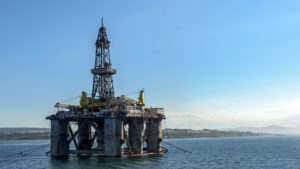You have a plumbing problem. Leaking pipes, they need repair. Oh, and did I mention you’re 200 miles offshore in the middle of the Gulf of Mexico? This is a job for a team with special skills like the ones at TDT Plumbing that they bring to every job. Gary Gould from TDT Plumbing is with us here to explain how they handle projects like this and what it means to your home or your business.
Transcript:
GARY: Hi, Charlie.
CHARLIE: Gary, whether it’s in my house or an oil platform, isn’t a leaking pipe a leaking pipe?
GARY: Absolutely. One thing people don’t like is when your ceiling falls in or you have water on your electrical components. A leak is a leak is a leak and I don’t know very many that are good leaks.
CHARLIE: Right. So how does it differ when you’re … Like we were talking about this, where you’ve been on this offshore platforms 200 miles offshore. How does it differ in dealing with a leak like that?
GARY: For offshore leaks, clearly we have to keep into consideration travel and getting out there, usually by helicopter. Once you get everything to where you need to be, though, the leaks are very similar. A domestic water, cold or hot water leak, is a pin hole or it’s a bad fitting or connection or something like that; pipes corroded or eroded away. We saw those problems in the same exact fashion offshore as we would onshore. Whether we’re on a boat, whether we’re on a platform, whether we’re in a hotel or apartment complex or over at my house down around the corner, it’s very similar piping systems. And we fix them in a way that’s very similar.
Examples of common offshore plumbing problems
CHARLIE: So what are exactly were some of the problems that you solved when you were on some of these offshore platforms?
GARY: On one very large production platform, they had failing stainless steel water lines. Just so happened to be the lines that supplied all of the living quarters, so your showers, your commodes, your kitchen. And, I’ll tell you, you have 100 persons out on a platform and the kitchen can’t operate because the pipes are leaking and shut off, people get ornery very quickly. So what we do is we go in and these systems that are failing … For a host of reasons, just failure of the pipe, we come in and isolate sections and restore them and then we don’t hear from them for a very, very long time.
So we’ve done domestic water lines. We’ve done fire water lines on a different platform. On boats, we’ll do tanks, like the big domestic water tanks, the plumbing and galvanize and steel pipes that connect everything together, ballast tanks. So there’s a whole lot of plumbing on offshore rigs and boats.
CHARLIE: And this is a job for ePIPE.
GARY: We definitely use our ePIPE or epoxy coated technology for the bulk of what we’ve done offshore.
CHARLIE: Are there other techniques you had to use out there?
GARY: We’ve used our cured-in-place pipes, which is a little bit different. It’s designed for bigger diameter pipes typically. And so we’ve used that technology as well.
CHARLIE: How does that differ from what you would use in hotels and homes on dry land, Gary?
Is there a difference between residential and offshore plumbing?
GARY: There’s very little difference. Clearly offshore, the surrounding aspects are different because you’re floating like a bobber in the middle of the ocean, but the technology, the application and the crews that we use are the same. So we do the exact same thing at your house down on a cul-de-sac. We isolate things a little bit different when it’s a bigger building, 7, 10, 20 story building. But you basically are isolating sections of pipe. The diameters are the same. The use is the same and so from offshore to onshore, you’d be surprised at the similarities.
 CHARLIE: We’re visiting with Gary Gould from TDT Plumbing. They’re experts in leak detection and in-place pipe restoration using the ePIPE epoxy repair and cured-in-place pipe repair. Their technologies they use in your home, your business and as we’re hearing today, out on the high seas. What is it like, Gary? I mean, to organize your team to get out there. It’s one thing if you come to a neighbor and you forget a part, you can send a runner for it. There must be an enormous amount of preparation for taking a crew to go out and repair something 200 miles offshore.
CHARLIE: We’re visiting with Gary Gould from TDT Plumbing. They’re experts in leak detection and in-place pipe restoration using the ePIPE epoxy repair and cured-in-place pipe repair. Their technologies they use in your home, your business and as we’re hearing today, out on the high seas. What is it like, Gary? I mean, to organize your team to get out there. It’s one thing if you come to a neighbor and you forget a part, you can send a runner for it. There must be an enormous amount of preparation for taking a crew to go out and repair something 200 miles offshore.
GARY: You bet. And I’ll tell you, it’s good for our company because we’ve had to go through Coast Guard for approvals to use the products offshore. So you have to go through a process. But when we are in preparation, we will mock-up things here at our shop. We have to load down containers and basically, work with the engineers and offshore personnel to bring together the package. And you look at that package and you look at, well, what could go wrong; what extra goodies do you plan on bringing? We really have to load down, prepare, have extra stuff, whether it’s floor protection or gloves. I mean, just right down to every nut and bolt.
And often these rigs have had previous leaks and so we find ourselves having to adapt to maybe what Joe the Plumber did or the maintenance man or something else. And then, what’s even more complicated is going from metric standards to English standards to different types of threads and fittings or whatever. So we really have to do a complete and thorough examination and mock-up up front. Then we move everything off in containers, get our job done, bringing it all home. It’s really neat to be involved in that stuff.
CHARLIE: The logistics of it is just mind boggling. I mean, it’s almost like a moon mission.
What are the logistics with jobs like this?
GARY: It is something else. I tell you, these guys that work offshore … The planning. We may plan a half a year or a year in advance in preparation to going out and as our company moves into the facility, our goal, of course, is to get in and get out. It’s all about taking everything that we’ve practiced and learned up front, to go in and be thorough, be precise, get our job done and get off the boat. It’s important for them. We try to be seamless where there’s no production loss whatsoever. We’ve been very, very successful in that.
CHARLIE: What have you learned with these offshore adventures of yours that’s impacted the projects that you do here on dry land? I mean, have there been takeaways that have changed your process or informed how you do things in homes and businesses on dry land?
GARY: Well, with our experience, clearly there’s a whole lot of folks that do general plumbing repairs here in Texas or here in Houston. And it’s a completely different approach. So we look about the methodology. We look at the process. We look all of the layers of safety. There’s a lot of safety involved. We take our products, we make sure that we’ve mocked things up and if unique circumstances, that we’re prepared to take care of those. When you come back to the states, I think when you walk into an apartment complex or tower or building, like an office building, it fits right in.
And I’ll tell you, as a homeowner, you want people to come in and be professional. Don’t want a bunch of people walking around not knowing what’s going on. And so the trickle down is nice, the communication is great, but it gives us a good process and a good procedure when we’re applying the product from the house to the office to the building. It’s great.
CHARLIE: TDT Plumbing is a full service plumbing company. They specialize in leak detection, re-piping, pipe restoration, cured-in-place pipe repair, and of course, the Jolly Roger work out on oil platforms offshore. Gary, thanks so much for your time today.
GARY: Thanks a bunch. Appreciate it.
CHARLIE: Before I forget, check out the rest of their website for videos and case studies of projects of every skill. You’ll find all that and much more here at tdtplumbing.com.
